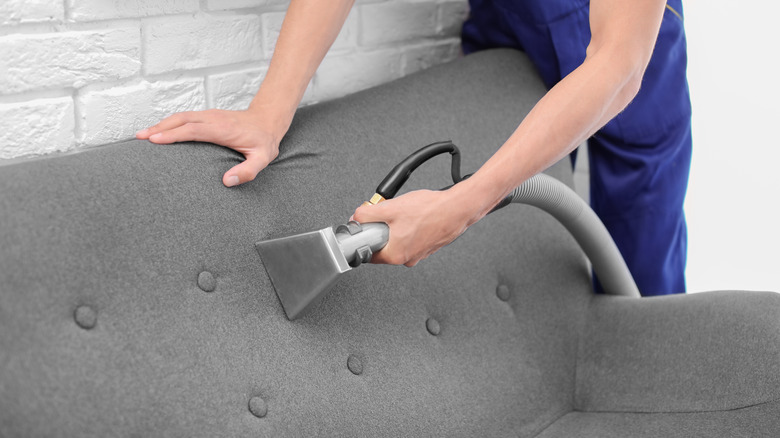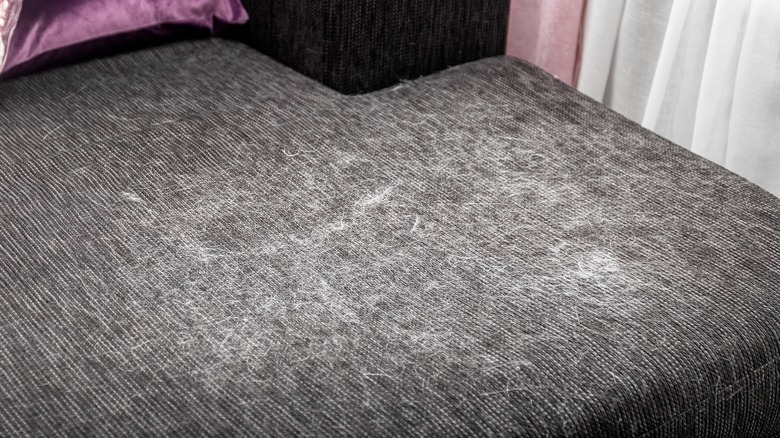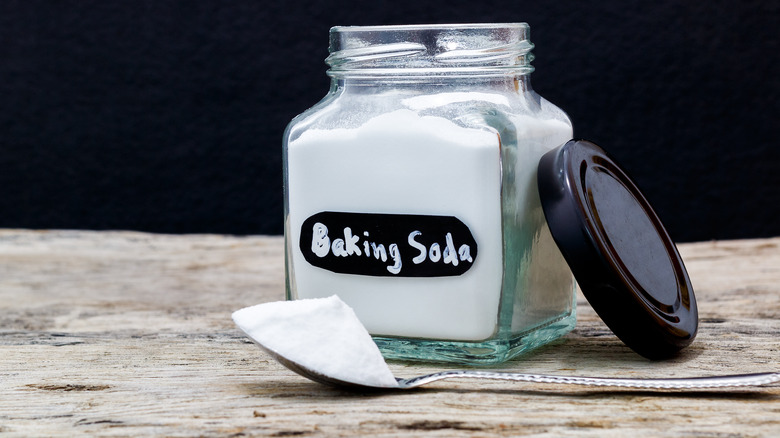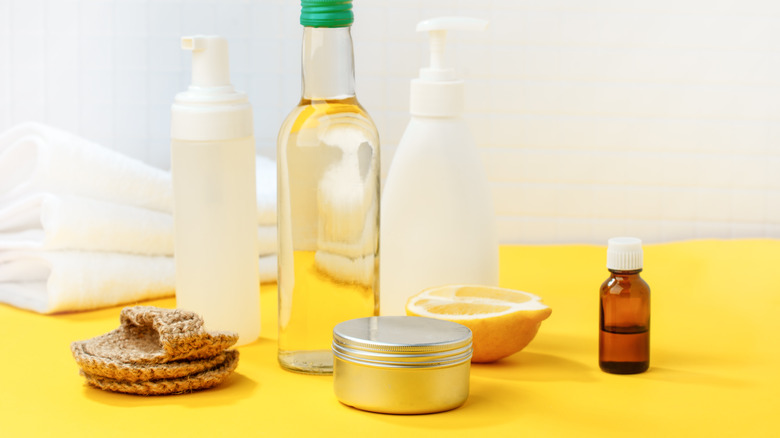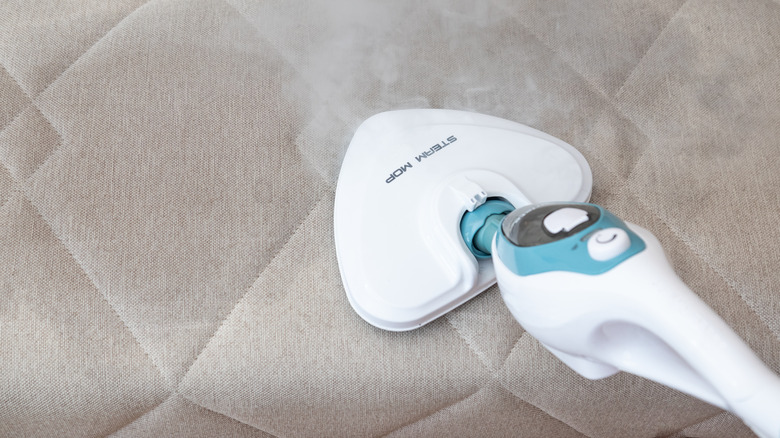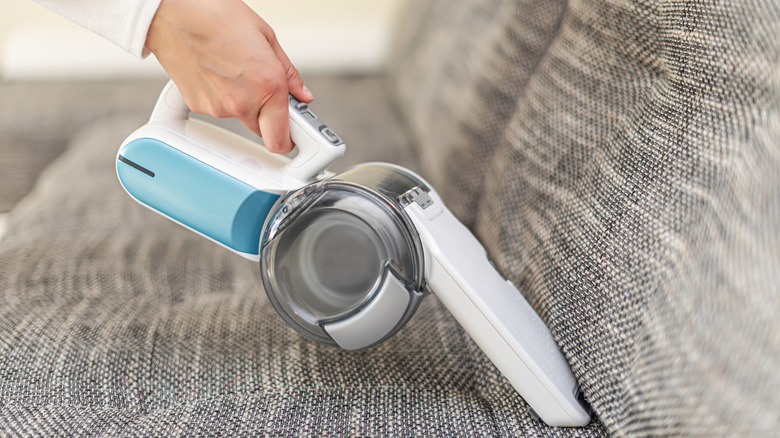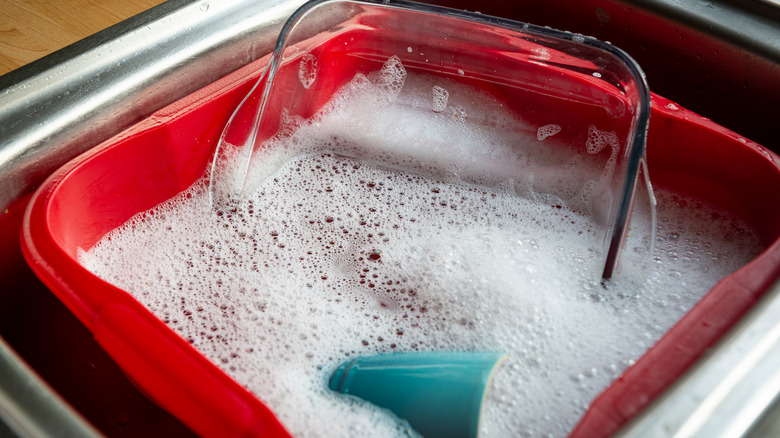5 Best Ways To Clean Cotton Furniture
Cotton furniture is soft and heavenly until you tip your glass of red wine, and then it becomes a tragedy. This is because cotton is a pro at absorbing substances, so cleaning the spill will be a real task, per Yorkshire Fabric Shop. You don't have to splurge your cash on fabric cleaners at Walmart because there are several ways you could get that stain out with simple household items like baking soda and vinegar.
Cleaning your furniture should not only be done when you have a stain. The Pro Housekeepers suggest cleaning it at least twice a year and vacuuming your cotton sofa weekly. Disinfecting every month is also advisable since cotton fabric inhabits a lot of bacteria and absorbs moisture. Plus, your pets won't be able to resist its softness. So compared to other types of materials, cotton does require more attention. Nevertheless, here are a few ways you can clean your cotton furniture easily in different situations.
1. Prep your couch
There are five primary ways to clean your cotton furniture, and all will do a thorough spick and span job. The items required include rubber gloves or lint remover, vinegar, dish soap, water, baking soda, cleaning agent, vacuum cleaner, sponge, paper towels, dry rags, and a scrubbing tool. The relevance of these tools will vary depending on the state of your furniture and what you intend to clean. Before you start cleaning, always do a spot test to see how your fabric reacts to the product, per Merry Maids.
Begin the process by prepping your furniture. If you are cleaning a cotton sofa, remove all the cushions and items that will hinder your progress. Smack the cushions against a wall or your palm to remove dust before putting them away. If you have a furry pet, you probably have hairs on your couch. We suggest wearing rubber gloves to gather them into a ball by simply rubbing your hands across the furniture. The hair gets attracted to the rubber gloves like a magnet. You could also use a lint remover or sticky tape.
2. Cleaning with baking soda – odor removal
If you have a case of smelly furniture, baking soda is the ingredient for the job. This heavenly agent not only captures bad odor but also loosens dirt and refreshes your furniture, per Merry Maids. Sprinkle a thin layer of baking soda on the entire surface, and let it sit for 30 minutes or more, depending on the gravity of the smell. Go in with a vacuum after, and your furniture will be good as new. Note that baking soda should not replace deep cleaning, disinfecting, and spot cleaning.
If you want to use baking soda to remove tough stains, make a paste with water and apply it to the stain with a cloth or your fingers. Do this gently so the dirt doesn't sink deeper into the fabric. You don't need to scrub; just leave it on for 15 minutes or more. When the baking soda has absorbed the stain, brush it off or vacuum it away, via Fantastic Cleaners. To use baking soda as a deep cleaner, replace the water with upholstery or carpet solvent to make the paste.
3. Cleaning with vinegar and dish soap – spot cleaning
White vinegar is a must-have agent when performing DIY cleaning jobs, and it's great at removing tough stains and safe for fabric. Mix three tablespoons of vinegar into half a bowl of warm water. Add a spoon of dish soap and gently use a sponge to blot the mix onto the stain. But before doing so, try loosening up the blemish by scraping it inwards and then dusting it off, per Plumbs.
Try not to soak the furniture; instead, scrub the stain gently, so it remains on the surface and doesn't penetrate deeper into the foam. Use a clean non-dye rag (it won't bleed onto your cotton upholstery) to wipe off the residue and air dry, via Pro Housekeepers. If you want to clean the entire surface of your furniture, use a spray bottle to spritz the mixture 30 centimeters away. Then use a clean cloth to wipe the excess residue. After it air dries, the vinegar smell will leave, and your furniture will be refreshed, via Fantastic Cleaners.
4. Steam cleaning
Steam cleaning is the easiest way to get all that nasty stuff out of your furniture foam. But unfortunately, this method is not suitable for every couch. Before you consider steam cleaning, check the user manual for directions. If your couch is tagged "WS" or "W," it can be cleaned with water or a solvent and will not damage under steam, via Oh So Spotless.
Merry Maids agree with us on vacuuming your couch before and after steam cleaning, as it will give you a better result. Changing the microfibre dust collector in between cleaning is also advisable to absorb as much dirt as possible. It's best to steam clean during a sunny or warm day so that your furniture can dry quickly and your room can be free from steam. You can direct a standing fan onto the cotton couch to dry if the weather changes.
5. Deep cleaning furniture
Deep cleaning should be done at least twice a year, and you must get between those crevices to eliminate dust mites and dirt and retrieve lost items. To deep clean, Pro Housekeepers offer a simple step-by-step process. First, loosen up the dirt by brushing the furniture's surface, and you can use a dry, non-dye cloth or a stiff brush. Afterward, go in with the brush attachment on a vacuum to clean all the dirt, crumbs, and hair. Remove the cushions and sprinkle baking soda lightly across the furniture's surface, leaving it for 20 to 60 minutes.
If your cushions have removable covers, wash them, focusing on the foam. If they are not removable, make a vinegar and water mixture in a spray bottle and spritz it across the surfaces of the cushion. Spray an extra layer on stubborn spots and scrub if desired. The upholstery might be damp, but you don't have to blow dry it. Simply leave it in an open space to dry on its own, per The Cleaning Collective. Clean the wooden or metal frame of the furniture with a damp cloth and mild detergent. Then brush up all the baking soda, clean stubborn stains, and leave your furniture to air dry, via PopSugar.
6. Cleaning with detergent and disinfecting
If you bought your furniture from a store, it probably came with a user manual and cleaning tag. The Furniture Repairman offers an excellent guide detailing the types of cleaning tags and their meanings — it will show you what cleaning process to use to ensure your couch is free from damage. If you want to use detergent powder, make sure the detergent is upholstery-friendly and mild. Mix two spoons of detergent with a cup of water and use a sponge to rub against the stains. Don't make the area too wet, and scrub gently too. When the stain lifts, use a paper towel and water to wipe it away, and air dry as usual, via Pro Housekeepers.
Disinfecting your couch is a perfect way to prevent bacteria from building up. Antimicrobial oils, like tea tree oil, are perfect for this job. Alcohol is also an excellent agent to kill bacteria. Mix two cups of alcohol and some drops of tea tree oil into one cup of water. Use a spray bottle to spritz this mixture across the cotton surfaces of your furniture; let the solution sit for some minutes and vacuum after.
